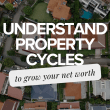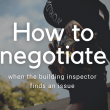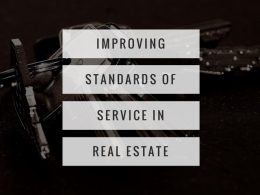In the aftermath of the Global Financial Crisis, I stumbled upon a marketing strategy which unlocked consistent commission income and a never-ending supply of listing opportunities. With zero cold-calling or knocking on doors.
It was early 2007. I was 22 years old and I had just decided to embark on a career in real estate.
Full of big dreams and boundless enthusiasm, I scrapped through my first year by chasing foreign listings that had been on the market 3+ months. I only had one suit and I wore it 6 days a week, to the point where you could see a shiny ‘stripe’ where my seatbelt had rubbed against the cheap fabric, giving it that glossy look.
I hit on a few lucky breaks that helped me survive that first year. My best friend’s older brother sold his home and took a chance on me. I also obtained the un-obtainable in real estate: I got a listing from doing floor time!
I thought I was ready for the big time.
Then 2008 came along and the Global Financial Crisis hit. Boom. Just like that, the market ground to a halt.
Podcast version:
Suddenly, no one wanted to move
In New Zealand, homeowners hate losing money on property. So instead of selling up and seeing big price drops, everyone just stayed put and decided not to move. Sales volumes fell off a cliff.
In some ways it was worse than a big price drop in the market. There were suddenly hundreds of real estate agents in my city, sitting around with nothing to do. For the few houses that were on the market, they went from having 20 groups through a 30 minute open home, to having 2 groups on a good day. Listings could often go weeks without a single visitor or even a phone call.
It was ‘make or break’ time
Despite the market conditions, I was determined to succeed. Failure simply wasn’t an option. I was the youngest salesperson in my office by 20+ years and there was a general perception that I didn’t have the life experience to succeed. I was determined to prove everyone wrong.
When volume drops in a down market, agents suddenly get super competitive. Every listing is gold, especially a marketable one. Nothing was going to come easy in that kind of environment.
If I was going to have any chance of surviving, I needed a way to stand out from the crowd. I needed to position myself as the expert in my local area.
I didn’t know it at the time, but I was soon to discover a strategy that would unlock a consistent flow of listing opportunities and regular commission income for many years to come.
It’s called content marketing*
It involves zero cold-calling whatsoever and it allows you to build an attraction business where you don’t need to go out and find potential sellers. They come to you.
Better still, if you consistently employ a content marketing approach, you will often be the only agent they call in.
I’ll explain how this all works. But first, we need to lay some groundwork…
Step 1: In a changing market, embrace a positive mindset
The first trend I noticed after the real estate market changed, was the depressing outlook embodied by many experienced agents. Their incomes had halved (or worse) and you could see it on their faces. They were disheartened. They talked negatively about the market to their clients. They were depressing to be around.
It dawned on me that buyers and sellers don’t want to hear about how tough things are for you. They want strategies and answers and positivity.
If owners are selling in a down market – and trust me, there are always people who need to sell, then what do they need? The answer is, solutions.
If you are working in a changing market, your clients already know it’s probably not an ideal time to sell. You don’t need to remind them of that. You need to be the voice of positivity and to employ a solution-focus at all times.
Here is an example of the kind of dialogue that works in a tough market:
Owner: “How many groups did you have through today?”
Agent: “Look, we only had 1 group and they didn’t stay long, but hang in there, I’m determined to find the right buyer for your home. So here’s what I’m going to do – I’m going to change the advert online, switch the main photo and if that doesn’t generate more activity, we’ll sit down and talk about whether we need to re-position our pricing strategy. But in the meantime, I want to try these other options first…”
See what’s happening with that kind of discussion? You are fostering hope. You are showing that you care, that you have solutions, that changing the price is the last resort, not the first option.
Owners will listen to you when you first prove to them that you are working hard to protect the value of their biggest asset.
If those small changes to the advertising don’t work, you can ask for a price adjustment knowing you have fought hard for your owners first.
This positive mindset must extend to all parts of your life. One of the wonderful aspects of real estate is that every single person in your life could potentially refer you a listing opportunity.
So I’m going to make a bold suggestion…
No-one wants to refer a listing to a salesperson that is down about the market. So don’t ever talk negatively about the market to any member of the public. Not even your boyfriend’s mum. Just don’t do it.
The market is what it is. You can’t change that. There is no point being all doom and gloom about it. We just have to get on with helping people buy and sell.
Obviously, you don’t want to B.S people, so the best approach to take when someone asks you what the market is like, is to say: “UNBELIEVABLE!” in a very positive tone.
It could be unbelievably good or it could be unbelievably challenging. Either way, it doesn’t matter, as long as you are positive and have a solution-focused approach.
A changing market is the BEST time to grow your business.
While other agents are down in the dumps, sitting on their hands, you can be out there solving your owner’s problems, building your market share.
There are always people that have to move. Families grow, people pass away, marriages break-up, people change jobs and move cities. Are you going to be the one that helps them, or not?
Step 2: Engage in regular communication with your audience
After the GFC hit New Zealand back in 2008, I needed a way to generate listings as a young 23-year-old with no experience. I didn’t even own my own home at that point.
When establishing yourself in a new career in real estate (at any age) you have two key tasks. You need to tell everyone that you know that you are now in real estate, and you need to show them that you are proficient. That you know what you are talking about.
I needed to position myself as the local go-to real estate expert and I needed to go above and beyond to make up for what I lacked in age and experience.
How did I do it?
I started a weekly email newsletter and I consistently sent it out, week after week to everyone I knew.
Before getting into sales, I worked for a real estate CRM business. We had been trying to teach salespeople to send email newsletters for years. Few ever actually did it. The vast majority of the salespeople we trained wanted instant gratification, something that got them a listing this week. They failed to see the power of regular communication in a business like real estate, where there are years between each buying and selling decision and the contact to opportunity time-frame can often be 12-18 months or longer.
In the beginning…
At first, I started sending a plain-text email with a link to listings on my website. Boring! There was no HTML, no logo, no pretty pictures. It wasn’t even personalised. The first email went to a massive list of 15 people and half of those recipients were in my immediate family.
You gotta start somewhere, right?
I set a goal to add 5 new emails each week. From that point on, every single person I met went onto that email list. My hairdresser, the teller at the bank, my mortgage broker, that valuer I met for a coffee, my brother’s partner’s mum. Everyone.
The first few issues were incredibly simple, but I quickly started adding more content – a quote of the week, a one-paragraph update on the market, a few recent sales, whatever I could think of. Always positive. Always upbeat.
Key tip: You need to be able to send your email to everyone you know (not just current buyers), so they key is to add content that people will enjoy whether they are buying right now or not.
My email list quickly grew to a few hundred people. I always knew where my number of subscribers was at.
What gets measured, gets improved.
Peter Drucker
I started getting positive feedback from buyers. Listing opportunities started to trickle in.
Don’t underestimate the power of email
In real estate, you need a way to efficiently keep in touch with the vast majority of your audience who aren’t looking to buy or sell in the immediate future, while you focus on the people moving right now.
Email is a fantastic way to do this. It allows you to cost-effectively stay top of mind with everyone you have met throughout your career, along with people from networks you created before getting into property. It’s scalable, time-efficient, easy to set up and has great open rates. It also qualifies as soft-touch marketing, which is the ideal approach for clients who don’t immediately require your services (but will do, one day).
I kept adding anyone I had met (including open home visitors) to my email newsletter list. I found that unsubscribe rates stayed low as long as I was sending out engaging content consistently. I also refrained from asking for listings all the time or boring people with the usual, constant “now is a great time to sell” B.S.
By 2009 / 2010 the email newsletter had already become the foundation of my business. I started using a tool called Mailchimp to send emails which allowed me to make them look a little sexier.
By that stage, my email newsletter was going out to approximately 1,000 recipients. But I was still hustling for opportunities. Knocking on doors, dropping thousands of flyers, pounding the streets. I was selling a few houses and making decent money, but I wanted to level-up.
How to add value to your audience
I started writing short tips articles and added them to my email newsletter. Things like ‘5 questions to ask at every open home’. They were short and pretty rough, with hardly any formatting but my audience loved them.
Buyers and sellers are always desperate for good quality information.
Around 2012 I started taking these ‘tips’ articles and loading them onto a blog. That’s when the penny dropped. Owners want to do as much research as possible before they pick up the phone and call an agent. So I created a site where they could read articles that helped them make better buying and selling decisions. When it came time to sell, who else were they going to call?
Note: If you are just getting started, you don’t need to set up a blog to achieve this. You can use tools like LinkedIn or Medium to post articles and put a link to them in your regular email.
“But I suck at writing!” I hear you say.
Fear not, Agent Monday has got you covered.
The phone started to ring with multiple appraisal opportunities every week. By 2013 I had a team of 3 people (2 personal assistants and a buyer’s agent) and was consistently selling 50+ houses a year from that point on.
My email newsletter was going out to 2k+ recipients, with a consistent open rate of 30% plus. That means 30% of all emails sent out were opened, which is considered high in our industry.
When I asked potential sellers, “Why did you call me?” 90% of the time, the answer was, “Well, we were reading your articles” or “We’ve been getting your weekly email ever since we bought our home 5 years ago…”
A machine that produces appraisal opportunities
I stopped all other prospecting activities, aside from ‘we have a buyer‘ letters and concentrated on writing tips articles for buyers and sellers.
I had created a machine that ensured regular listing opportunities came my way, with zero door-knocking or cold-calling.
And the best part? When owners called me, they already looked at me as the expert. They were already confident that I knew what I was talking about. When I walked into their home, they were ready to listen to what I had to say. I didn’t have to spend the first 20 minutes of the appointment trying to establish my credibility. It made listing opportunities easier and faster.
Often, I was the only agent they called in.
Here is a summary of the key things I learned on this journey:
- No matter what the market is doing, always be the voice of positivity.
- No matter how quiet the market is, there is always something you can change about a listing to help find a buyer – change a headline, change the main photo, post it on social media, drop flyers. Check out the Agent Monday ‘Listing Refresh Checklist‘ for ideas.
- You need a way to keep in touch with all the people you have ever met, especially the ones who aren’t selling right now. In real estate, every single person in your community (and beyond) is a potential source of new business. The easiest and cheapest way to do this is via email.
- You need to make sure your email newsletter stands out.
- You need to be consistent and send it out every week (or every fortnight, at least).
- Add everyone you meet to your email list.
The hardest aspect of sending a regular email newsletter was coming up with the content each week. Sitting down to write a tips article for buyers or advice for sellers is tough when you have 7 phone calls to return, emails piling up and offers waiting to be presented. Or worse, when you have no listings, are lacking in confidence and don’t know what to say or where to begin.
That’s why I created Agent Monday. As a member, you are part of an exclusive group of salespeople who receive a brand new article, written by me, in your inbox every week. Along with tools and ideas to help you grow your business and sell more properties.
You can use these articles any way you like. Here are a few ideas to get you started.
The best part about being a subscriber is that it takes all the hurdles out of the process. You have instant access to all the content you’ll ever need to send out an engaging email newsletter to your database. Excuses be gone!
What are you waiting for?
The best way to build a real estate business with a consistent, steady flow of income is to build a communication machine that allows you to efficiently keep in touch with a large group of people while showing them that you are THE go-to real estate expert in your local area.
Join Agent Monday today. Early-adopter pricing available for a limited time.
What happened to my email list in the end?
I still send out emails using Mailchimp to thousands of people who I met during my real estate career, even though I no longer sell houses. Some of the recipients have been on my email list since the very beginning.
Since I’m not trying to generate listings, I now send out one issue per month. Click here to view an example (from July 2020). If you would like to subscribe to my personal email list for inspiration, click here.
*What is Content Marketing?
Content marketing is a long-term strategy that focuses on building a strong relationship with your target audience by giving them high-quality content that is relevant to them on a consistent basis. Eventually, when customers make a real estate decision, their loyalty already lies with you. You are in prime position to secure their listing or help them find a home.
This post was originally published on agentmonday.com









